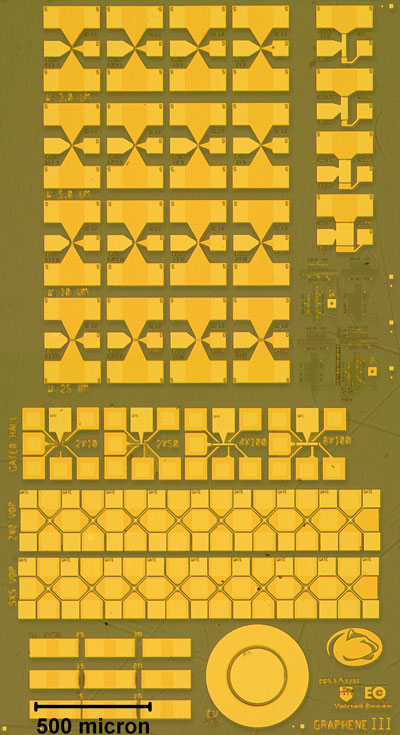| Aug 31, 2011 |
Adding hydrogen triples transistor performance in graphene
|
|
(Nanowerk News) A technique that uses hydrogen to improve transistor performance on real-world graphene devices has been demonstrated on the wafer-scale by researchers in Penn State's Electro-Optics Center (EOC). In a paper published in the August 1, 2011, online edition of Nano Letters, the researchers demonstrated a 3x improvement in electron mobility of epitaxial graphene grown on the silicon face of a 100 mm silicon carbide wafer, as well as a similar improvement in radio-frequency transistor performance.
|
|
"There are two faces to a silicon carbide wafer," explains EOC materials scientist Joshua Robinson. "Graphene grown on the carbon face usually has higher electron mobility, but that's because beneath the graphene layer grown on the silicon face there is a carbon-rich buffer layer bound to the silicon carbide that acts to scatter electrons, thus reducing their mobility. If you can get rid of the buffer layer, the electrons will go much faster, which means your devices will work faster. It is also easier to control the thickness of the graphene on the silicon face, which is crucial if you want to make highly uniform wafer-scale devices. That's what we've been able to do."
|
 |
| Optical image of transistors and structures to test device performance on hydrogenated epitaxial graphene.
|
|
The paper, titled "Epitaxial Graphene Transistors: Enhancing Performance via Hydrogen Intercalation", reports an extrinsic cut-off frequency of 24 GHz in transistor performance, the highest reported so far in a real-world epitaxial graphene device, the authors believe. (Extrinsic cut-off frequency is a measure of device speed under operating conditions, and is typically a fraction of intrinsic speeds often reported.)
|
|
The hydrogenation technique, which was first developed by a group in Germany (Riedl, et al.; Phys. Rev. Lett. 2009, 103, 246804), involves turning the buffer layer into a second, free-floating one-atom-thick layer of graphene by passivating dangling carbon bonds using hydrogen. This results in two free-floating layers of graphene.
|
|
Penn State researchers, led by Joshua Robinson and David Snyder, have implemented an additional process step to their wafer-scale graphene synthesis process that fully converts the buffer layer to graphene. With this hydrogenation technique, the epitaxial graphene test structures showed a 200-300% increase in carrier mobility, from 700-900 cm2/(V s) to an average of 2050 cm2/(V s) in air and 2375 cm2/(V s) in vacuum.
|
|
The Penn State team, which includes lead author Robinson, David Snyder, Matthew Hollander, Michael LaBella, III, Kathleen A. Trumbull and Randy Cavalero, intend to use this technique to improve transistor performance in radio frequency devices. "Graphene's ambipolar conduction allows you to simplify circuits, while its high mobility and electron velocity provides a means to get to terahertz operation. The problem is that the exemplary frequency response reported to-date in the literature is not the real-world performance.
|
|
Hydrogenation and device scaling gets us much closer to true high frequency performance," Robinson remarks.
|
|
In a second paper in the same issue of Nano Letters, the group also reports a novel oxide seeding technique by atomic layer deposition they developed to deposit dielectric materials on wafer-scale epitaxial graphene. Their technique resulted in a 2-3x performance boost over more traditional seeding methods. The authors believe that these two advances constitute the next building blocks in creating viable graphene based technologies for use in radio frequency applications. The second paper, "Enhanced Transport and Transistor Performance with Oxide Seeded High-κ Gate Dielectrics on Wafer-Scale Epitaxial Graphene"," was coauthored by Matthew J. Hollander, Michael LaBella, Zachary R. Hughes, Michael Zhu, Kathleen A. Trumbull, Randal Cavalero, David W. Snyder, Xiaojun Wang, Euichul Hwang, Suman Datta, and Joshua A. Robinson, all of Penn State.
|

